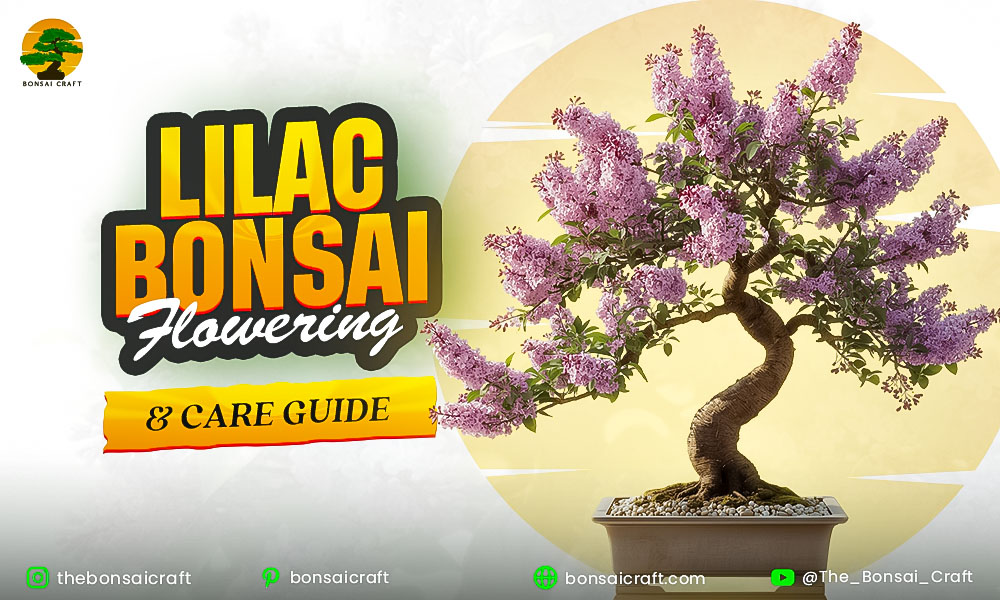
A lilac bonsai is one of the most captivating miniature trees you can grow, admired for its fragrant purple blooms, elegant structure, and delicate beauty. Whether you’re a bonsai enthusiast or a beginner, cultivating a bonsai lilac brings the charm of spring right into your garden or indoor space. With proper care, pruning, and patience, your lilac bonsai tree will reward you with stunning flowers and a soothing aroma year after year.
In this complete guide, you’ll learn how to grow, shape, and care for lilac bonsai both indoors and outdoors — including watering, soil, pruning, flowering care, and winter maintenance tips.
What Is a Lilac Bonsai?
A lilac bonsai is a miniature version of the lilac tree (Syringa vulgaris), which is known for its clusters of sweet-smelling purple or white flowers. When trained as a bonsai, it combines the aesthetic appeal of a flowering shrub with the art of bonsai styling.
A lilac bonsai is a small, carefully pruned version of the lilac tree grown in containers. It produces fragrant, purple or white flowers, symbolizing renewal and love. Proper care includes regular pruning, sunlight exposure, and well-draining soil.
There are several varieties suitable for bonsai cultivation, including the Korean lilac bonsai (Syringa meyeri), which has compact growth and small leaves — ideal for miniature form.
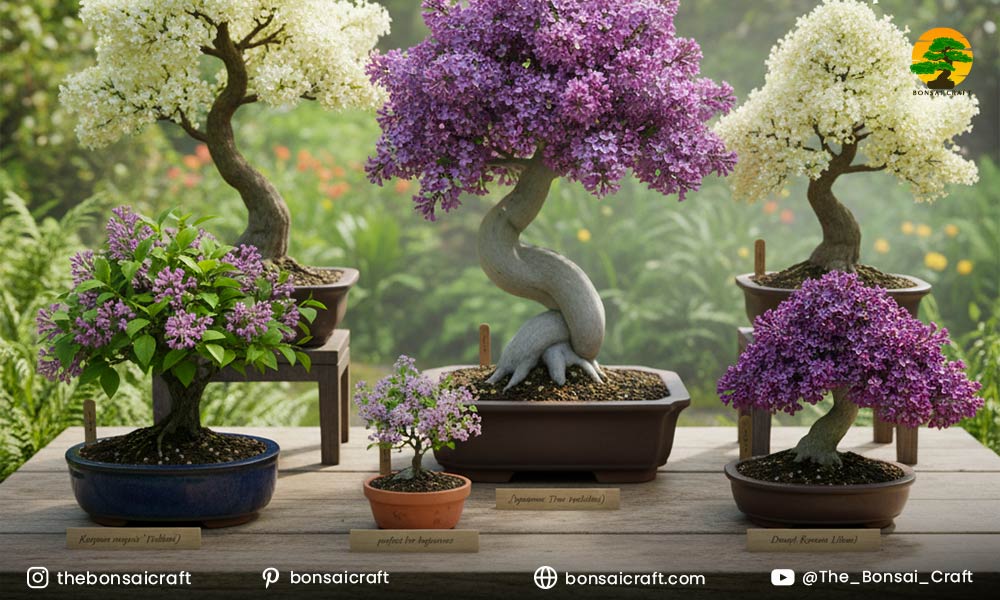
Types of Lilac Bonsai
- Common Lilac (Syringa vulgaris): The classic with purple fragrant blooms.
- Korean Lilac (Syringa meyeri ‘Palibin’): Slow-growing, compact, and perfect for small pots.
- Japanese Tree Lilac (Syringa reticulata): Tougher branches & larger flowers, great for outdoor bonsai.
- Dwarf Korean Lilac: Beginner-friendly and low maintenance.
- Fragrant Purple Lilac Bonsai: Dense flowers with beautiful clusters and fragrance.
Each of these bonsai lilac varieties adapts well to pruning and wiring, making them perfect candidates for bonsai styling.
Is Lilac Bonsai Indoor or Outdoor?
A lilac bonsai needs to fully grow outdoors to get full sunlight and fully adjust to changing temperatures. You are allowed to keep them indoors for short periods or during bloom stages as long as they receive lots of light.
Explanation:
Lilacs are deciduous trees and need to go dormant during the winter. If they are kept outdoors, it gives them larger cycles of healthier growth. If brought indoors, they can become stunted with poor growth, dry air, and warm temperatures.
If you keep a lilac bonsai indoors, place it by a south-facing window or under a grow light for 6–8 hours a day.
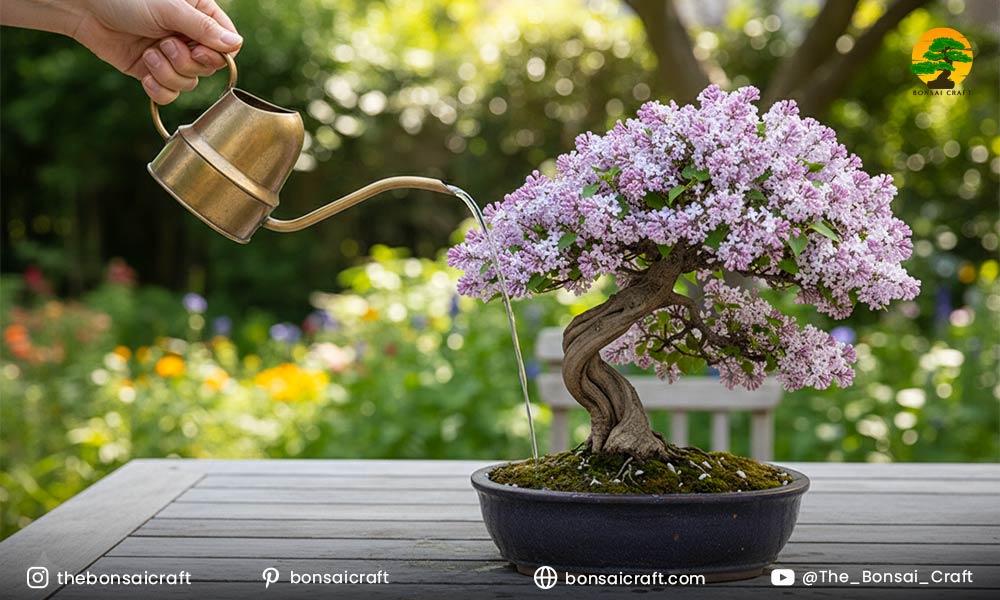
Lilac Bonsai Watering Guide
Proper watering is the foundation of lilac bonsai care. Lilacs prefer slightly moist but not soggy soil.
- Watering Frequency: Once the topsoil feels dry (1 inch deep).
- Technique: Use a gentle watering can or misting system to evenly moisten the soil.
- Avoid: Letting the soil dry out completely or stay waterlogged.
💡 Pro Tip: During the flowering period, increase watering slightly to support bloom production, but ensure good drainage to prevent root rot.
Best Soil Mix for Bonsai Lilac
A well-draining mix keeps the roots healthy and prevents fungal infections. The ideal bonsai lilac soil should retain moisture while allowing air circulation.
Recommended Mix:
- 50% akadama
- 25% pumice
- 25% lava rock or coarse sand
You can also add a bit of organic compost for nutrient balance. Repot your lilac bonsai tree every 2–3 years in early spring before new growth starts.
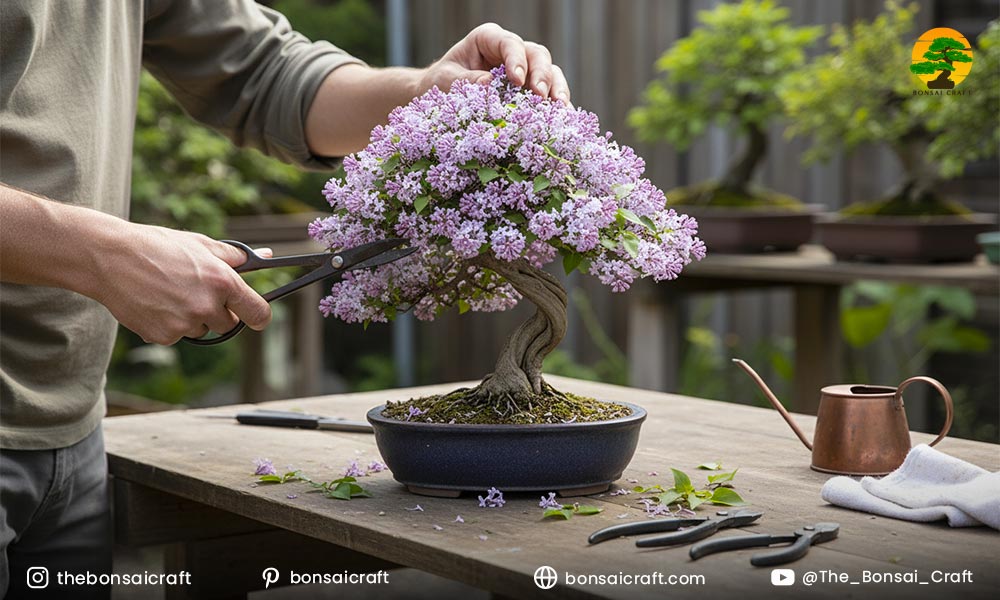
How to Prune a Lilac Bonsai Tree
To prune a lilac bonsai, remove dead or weak branches after flowering, trim new shoots to maintain shape, and thin out crowded areas to improve airflow. Avoid heavy pruning before blooming.
Detailed Pruning Steps:
- Timing: Prune immediately after flowering to avoid removing next year’s buds.
- Tools: Use sharp bonsai scissors or shears.
- Shaping: Focus on maintaining balance and symmetry in the canopy.
- Maintenance: Pinch back new growth to control size.
- Rejuvenation Pruning: Every 2–3 years, remove old wood to encourage new shoots.
Pruning enhances flowering and helps maintain the classic bonsai structure. Always sterilize your tools before and after use to prevent disease spread.
How to Make a Lilac Bonsai from Cutting
You can make a lilac bonsai from cuttings by taking 4–6 inch semi-hardwood cuttings in late spring, dipping them in rooting hormone, and planting them in a moist soil mix under indirect light.
Step-by-Step Process:
- Select a healthy branch with at least 2–3 nodes.
- Cut at a 45° angle below a node.
- Dip in rooting hormone to boost success rate.
- Plant in a small pot with moist bonsai soil.
- Keep in a warm, bright place but away from direct sunlight.
- Transplant after 2–3 months when roots form.
This method allows you to create your own bonsai lilac affordably while learning the process of propagation.
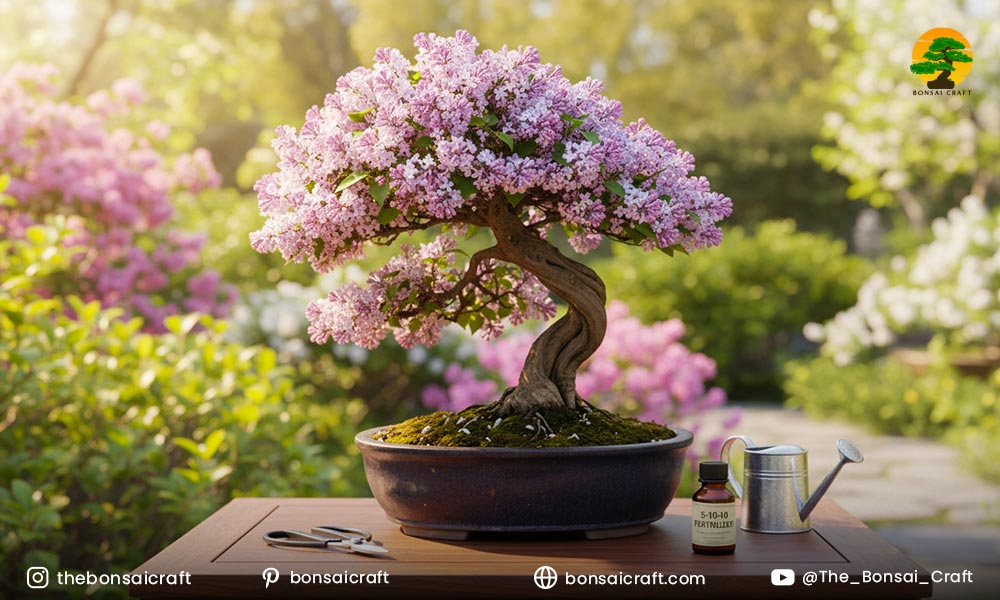
Encouraging Flowering in Lilac Bonsai
Flowering lilacs need sunlight, nutrients, and proper pruning. To ensure abundant blooms:
- Provide 6–8 hours of sunlight daily.
- Use a phosphorus-rich fertilizer (e.g., 5-10-10) during spring.
- Avoid nitrogen-heavy fertilizers that promote leaves instead of flowers.
- Prune after flowering, not before.
- Allow a winter dormancy period to trigger next year’s bloom cycle.
With care and patience, your fragrant purple lilac bonsai will blossom beautifully every spring.
How to Repot a Lilac Bonsai
Repot your lilac bonsai every 2–3 years in early spring to refresh the soil and prune the roots. Use a shallow bonsai pot with drainage holes and fresh, well-draining soil.
Steps:
- Gently remove the tree from its pot.
- Trim up to one-third of the root mass.
- Place mesh over drainage holes.
- Add a soil base layer and position the tree.
- Refill with soil and water thoroughly.
Repotting ensures healthy root growth and prevents compaction.
Winter Care for Dwarf Korean Lilac Bonsai
Protect your dwarf Korean lilac bonsai in winter by placing it in an unheated garage or cold frame. Water sparingly and avoid fertilizing until spring.
Lilacs require a dormancy period of 2–3 months below 45°F (7°C). Keep the soil slightly moist and avoid freezing conditions. Mulching around the pot can also help regulate temperature.
Styling and Display Tips for Bonsai Lilac
- Best styles: Informal upright, broom, or slanting.
- Display: Use glazed pots to enhance flower color.
- Wiring: Apply gently in spring; avoid wrapping too tightly.
- Aesthetic balance: Keep a proportionate canopy with visible trunk taper.
Your bonsai lilac tree can be a stunning centerpiece indoors for short periods during bloom, but it should primarily live outdoors for health and longevity.
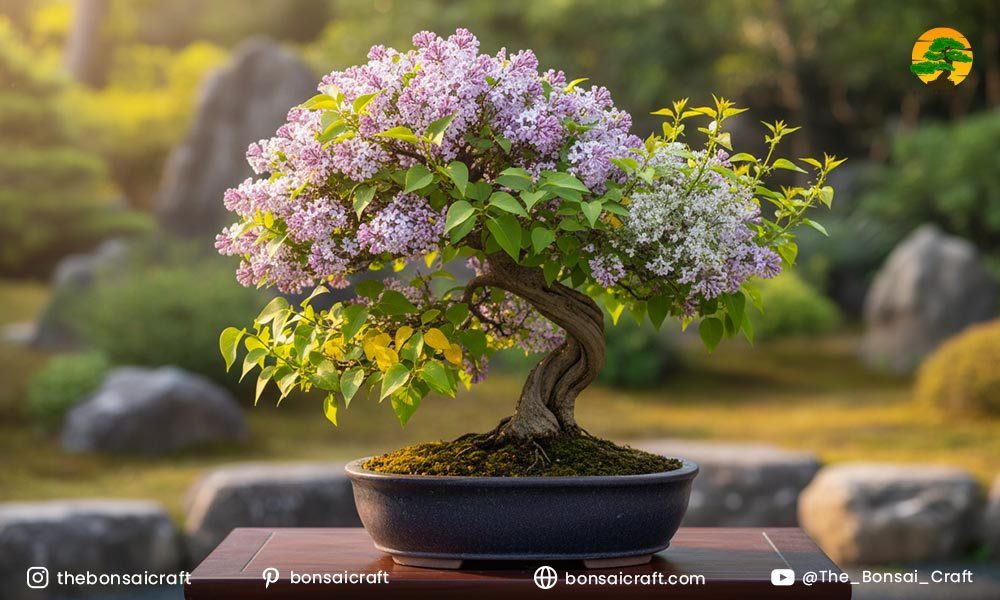
Lilac Bonsai Common Problems and Solutions
| Problem | Cause | Solution |
| Yellow leaves | Overwatering | Reduce watering and improve drainage |
| No flowers | Too much nitrogen / no dormancy | Adjust fertilizer and allow winter rest |
| Powdery mildew | Poor airflow | Prune and improve ventilation |
| Aphids | Pests | Use neem oil or insecticidal soap |
Conclusion
A lilac bonsai offers a perfect combination of beauty, fragrance, and symbolism. Whether it’s a Korean lilac bonsai or a fragrant purple lilac bonsai, the joy of nurturing and shaping it is unmatched. Remember: sunlight, correct pruning, and seasonal care are the keys to success.
Expert Tip:
Always prune after flowering and ensure your bonsai lilac gets proper winter rest — this is essential for next year’s bloom.
By following these care steps, your lilac bonsai tree will thrive for decades, becoming a symbol of patience and renewal in your bonsai garden.
FAQs About Lilac Bonsai Care
Can lilac bonsai grow indoors?
A lilac bonsai can be kept indoors temporarily during blooming, but it thrives outdoors due to its need for full sunlight and cold dormancy in winter.
How often should I water a lilac bonsai?
You’ll know it’s time to water your lilac bonsai when the top inch of the soil is dry to the touch. Lilacs enjoy moist soil, but don’t forget to water them because they can dry out.
When should I prune a lilac bonsai?
You should prune your lilac bonsai tree right after it has finished flowering. If you prune it before the flowering season, you will lose a lot of the blooms, as you will remove the buds.
How do I make a lilac bonsai from cutting?
To make a lilac bonsai from cuttings, take some 4 to 6-inch cuttings. Dip the ends in rooting hormone. Plant them in moist soil, and place them in indirect light until they root.
Why is my lilac bonsai not flowering?
Your lilac bonsai may not be flowering because it is not receiving enough sunlight, you are over-fertilizing it with nitrogen, or you are not letting it go dormant. Make sure you are only doing the proper pruning and it gets at least 6 hours of sunlight.
